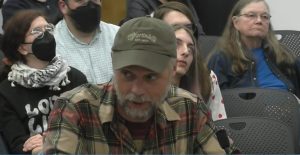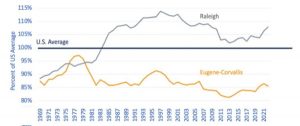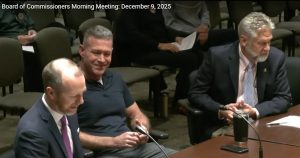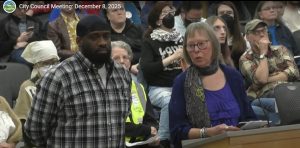Our current EMS coverage is dangerously inadequate
7 min read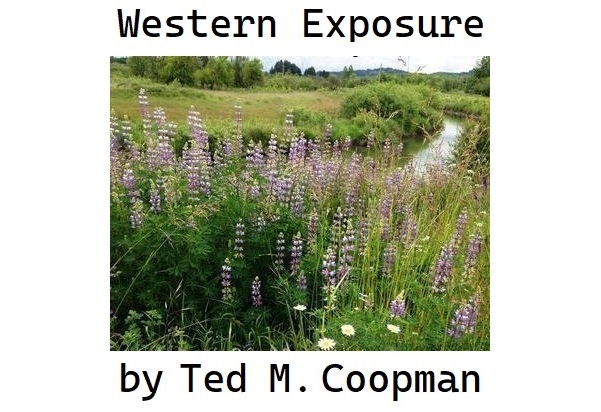
by Ted M. Coopman
A better way to pay
Any readers of this column know I am highly critical on how Eugene raises and spends money, especially after the City Council sandbagged a voter-submitted initiative to create an independent auditor via the tried-and-true method of putting a competing and confusing counterinitiative on the ballot to split the vote.
That said, the latest revenue idea of creating a special emergency services fee has merit.
Eugene Springfield Fire
Although local firetrucks are emblazoned with “Eugene Springfield Fire,” there are two distinct fire departments separately funded and operated by Eugene and Springfield. In this article, I am discussing Eugene’s equipment and service but will review Springfield’s services below as a comparison.
Under the merger each city pays for the staffing levels in its city – even though the personnel are blended and receive station assignments across the 16-station system as a single work force. However, the staffing numbers here apply only to operations and do not include the Fire Marshal’s Office, training, logistics, or administrative staff.
The problem: A disaster waiting to happen
Few people realize the desperate condition of emergency services in Eugene. The population of Eugene has gone from about 105,000 in 1982 to 175,000 in 2020. Yet the size of our local EMS has remained static.
- In 1981 Eugene had 45 firefighters and 2 supervisors and averaged 3,000 calls for service per year.
- In 2024 we have 46 firefighters and 2 supervisors who respond to about 31,000 calls for service a year.
That is an increase of 1000% for which Eugene has added – one firefighter (Eugene Fire Facts). Moreover, the national standard is four firefighters per truck, but Eugene can only staff three.
To look more closely at deficiencies, consider firefighter/paramedic ambulances. Eugene currently has four full-time staffed paramedic ambulances. According to Shekhar (2020), of 70 U.S. fire departments studied, each ambulance served an average of 21,057 people. Therefore, four firefighter/paramedic ambulances would normally serve a city of 84,228. To be on par with the national average, Eugene would need an additional four to five firefighter/paramedic ambulances, over twice what we have now.
As Eugene grows and gets denser with taller buildings, the need for more firefighters will rise beyond those required for regular population increases. In the 1980s, Eugene had 13 mid- to high-rise buildings. We now have 48, the tallest 18 stories, and that number is expected to increase to 55 by 2027.
There are several first responder problems with increased building height. First, the highest a ladder truck can reach is six stories. Second, the highest a truck ladder can effectively fight fires from the outside of a building is 11 stories. The result is, like many fire departments in urban centers with tall buildings, rescues and firefighting must be done inside on foot. That takes a lot more personnel who must be available and on duty.
While Eugene arguably needs more density, which means building up, there is no such thing as a free lunch when figuring the externalized costs and how to pay for them.
Eugene’s increase in population, combined with a steep rise in homelessness, creates a combined rise in call volume. While less than 2% of Eugene’s population is unhoused, they account for 25% of responses. This amounts to a significant hidden cost we all pay added to the already high costs of the impacts of people living on the street.
The result is our resources are overtaxed. To handle any significant emergency, Eugene would have to rely on mutual aid from nearby cities. However, the most likely significant events such as a massive nearby wildfire and wind event that would spread burning debris, or the predicted Cascadia Subduction Zone quake, would be regional, and those resources would be needed in their home jurisdictions.
Not only is Eugene short-staffed for everyday needs, but the city simply does not have any surge capacity. As we discovered during COVID, lack of excess capacity is lethal.
Springfield EMS
Springfield’s population is 60,827 and has 21 firefighters and 1 supervisor. That is a 1 to 2,896 ratio versus Eugene’s 1 to 3,888.
Springfield’s increase in call volume and population growth has been similar to Eugene’s. The difference between the two cities is that Springfield grew its fire staffing by 40% during the same time period, going from three to five staffed fire companies. Combined, Eugene/Springfield Fire serves about 290,000 people across both cities and ambulance service territory.
Continuing the example of firefighter/paramedic ambulances, the combined ambulance service area has seven advanced life support ambulances and 2.5 basic life support ambulances, which is about one ambulance per 30,500 residents, still well below the national standard of 21,057. Both cities operate their ambulance systems as an enterprise fee-for-service system. This means that to add ambulances, they must pay for themselves, and we are at max capacity with the revenue the system generates.
Equity
Since the blended service covers both cities, it is obvious that Springfield is carrying more than its share and Eugene far less. The median incomes and rents in both cities are roughly the same. To meet our collective needs, Eugene must be step up to reach parity as well as expand capacity.
To further complicate the picture, each city has contract districts that pay their own fees for coverage.
Springfield’s contract districts include Glenwood, the Rainbow Water District (Hayden Bridge area), and Willakenzie East RFPD (Rural Fire Protection District).
Eugene’s contract districts include Eugene 1 RFPD, Bailey Spencer RFPD, Zumwalt RFPD, River Road Water District, and Willakenzie West RFPD.
Needless to say, that is a lot of ground to cover.
The proposal
The Eugene Fire service fee would apply to property owners based on their property size, with the goal of raising $10 million per year citywide ($8 million to fund the existing fire service and $2 million to expand it).
The tiered fee would range from $3 per month for homes and businesses under 750 square feet to $1,752 per month for buildings over 300,000 square feet. A median single-family home (1,501 to 2,500 square feet) would pay $10 per month and the median commercial business (5,001 to 10,000 square feet) would be charged $38 per month.
Staff suggested Eugene use the same income qualification as EWEB and set aside 3% of the fire service fee money collected to help income-qualified owners pay the fee. This sort of revenue plan for emergency services is common and the proposed fee is on the low side. Fees are not considered taxes, so Oregon property tax limitations do not apply.
Property piggybank
Absent a sales tax, property fees are a go-to source for funding specific expenses like parks or infrastructure improvements. Property tax increases (like most general tax increases) are regressive in that they disproportionally impact low- and fixed-income homeowners.
While I am critical of the overuse of property tax fees as a dodge to avoid the bigger discussions of equitable ways to raise revenue, for certain specific uses with broad public applications and benefits (e.g. parks and infrastructure), these fees make sense.
One complaint about property fees and taxes is that renters can vote to increase owners’ property taxes for which renters do not pay. However, fee and tax increases can factor into rent increases, although this process has been somewhat derailed by rent control measures that cap yearly rent increases. Rents already typically rise as much as state law allows, but the increase will impact how rents are set for new tenants. In this way, rent control tends to benefit the small percentage of long-term renters at the expense of most typically more mobile renters. Granted, these increases are somewhat hidden.
The point is, in the end, everyone pays for higher property taxes and fees.
Budgeting bludgeon
In my run for city council, I had several long conversations with the International Association of Fire Fighters (IAFF). I got an earful about their concerns, especially around budgeting and lack of resources (FYI: The local IAFF chapter did not endorse anyone for Ward 1).
The mayor, every city councilor, and city management have been fully aware of the dire state of Eugene’s EMS system for years. Several councilors have tried to sound the alarm, yet the city has failed to act. Every budget cycle, in a twisted effort at equity, EMS services go on the chopping block along with everything else – with a wink and a nod that those services won’t get cut. This round there was talk of closing a fire station – even in the face of known, ongoing, and dangerously inadequate coverage.
This sort of game is devastating for planning and morale. Taking the allocation of funds decision on EMS outside the political budgeting process would insulate it from this perennial performative equity exercise. EMS fee dollars would be dedicated to EMS – period. We know what we would be paying for, and my own $120-a year-increase seems like an excellent deal in the event of an emergency.
Are Eugene residents willing to continue to roll the dice – with lives on the line – when it comes to emergency services? The average emergency response time in 2003 was 4.52 minutes. By 2024 that had increased 46% to 7.06 minutes (keep in mind, average means some response times are shorter while others are longer). Two to three minutes is a long time when you are waiting for help. Without more and predictable funding, it is only going to get worse.
Think we need better emergency services? Contact City Council and let them know.
For more information see https://www.youtube.com/@CityofEugene
Western Exposure is a semi-regular column that looks at issues and challenges from a West Eugene perspective – a perspective that is often ignored or trivialized by city leadership and influential groups and individuals largely based in south and east Eugene.
Western Exposure rejects the fauxgressive party line, performative politics, and “unicorn ranching” policy in favor of pragmatism focused on the daily experiences of residents and small businesses in Eugene—and West Eugene in particular.
Ted M. Coopman has been involved in neighborhood issues since 2016 as an elected board member, and now chair, of Jefferson Westside Neighbors and has 30+ years experience as an activist and community organizer. He earned a Ph.D. in Communication (University of Washington) and served on the faculty at San Jose State University from 2007 to 2020.
Ted’s research on social movements, activist use of technology, media law and policy, and online pedagogy has been published and presented internationally and he taught classes ranging from research methodology to global media systems. He and his spouse live in Jefferson Westside with an energetic coltriever and some very demanding and prolific fruit trees.
